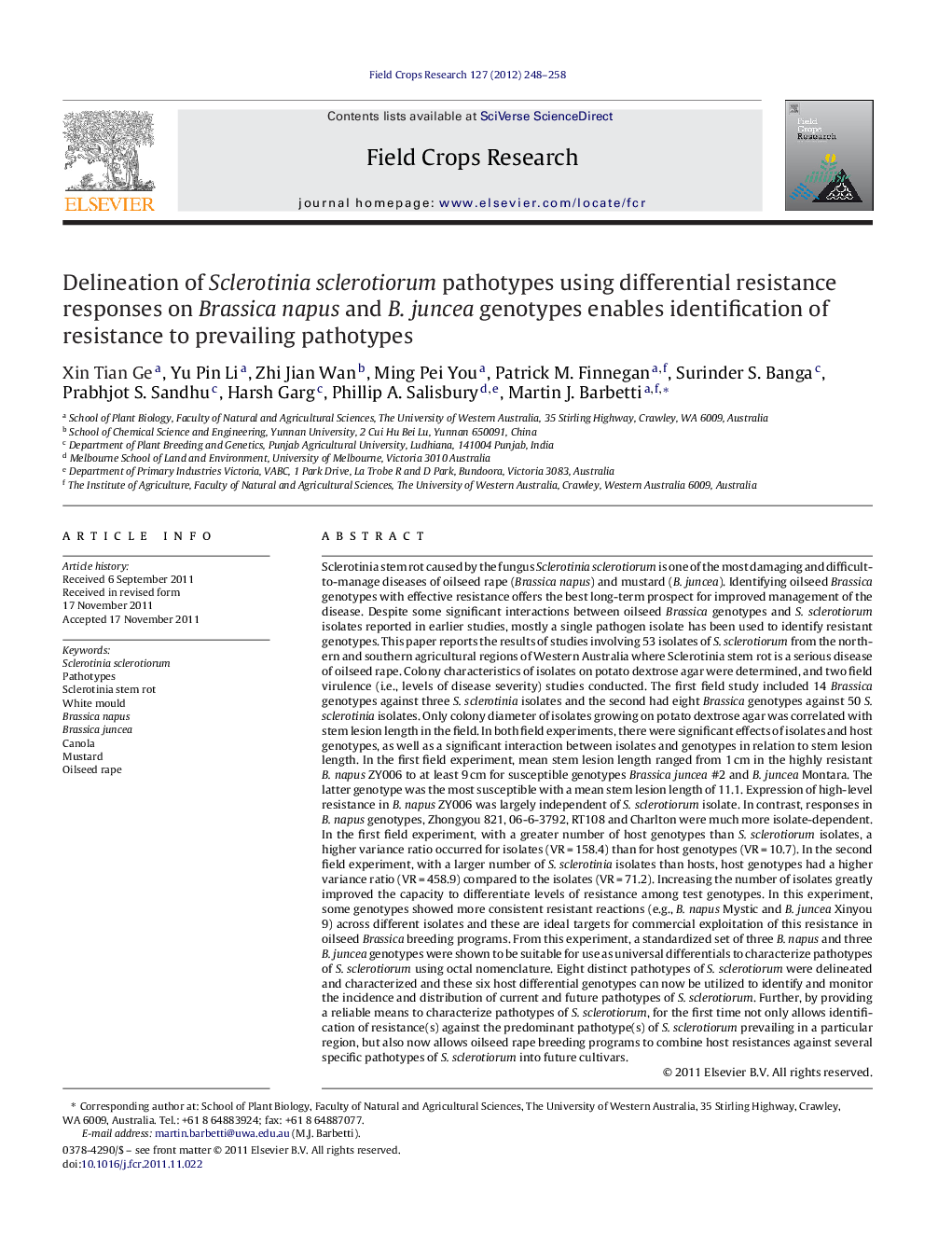| کد مقاله | کد نشریه | سال انتشار | مقاله انگلیسی | نسخه تمام متن |
|---|---|---|---|---|
| 4510718 | 1624736 | 2012 | 11 صفحه PDF | دانلود رایگان |

Sclerotinia stem rot caused by the fungus Sclerotinia sclerotiorum is one of the most damaging and difficult-to-manage diseases of oilseed rape (Brassica napus) and mustard (B. juncea). Identifying oilseed Brassica genotypes with effective resistance offers the best long-term prospect for improved management of the disease. Despite some significant interactions between oilseed Brassica genotypes and S. sclerotiorum isolates reported in earlier studies, mostly a single pathogen isolate has been used to identify resistant genotypes. This paper reports the results of studies involving 53 isolates of S. sclerotiorum from the northern and southern agricultural regions of Western Australia where Sclerotinia stem rot is a serious disease of oilseed rape. Colony characteristics of isolates on potato dextrose agar were determined, and two field virulence (i.e., levels of disease severity) studies conducted. The first field study included 14 Brassica genotypes against three S. sclerotinia isolates and the second had eight Brassica genotypes against 50 S. sclerotinia isolates. Only colony diameter of isolates growing on potato dextrose agar was correlated with stem lesion length in the field. In both field experiments, there were significant effects of isolates and host genotypes, as well as a significant interaction between isolates and genotypes in relation to stem lesion length. In the first field experiment, mean stem lesion length ranged from 1 cm in the highly resistant B. napus ZY006 to at least 9 cm for susceptible genotypes Brassica juncea #2 and B. juncea Montara. The latter genotype was the most susceptible with a mean stem lesion length of 11.1. Expression of high-level resistance in B. napus ZY006 was largely independent of S. sclerotiorum isolate. In contrast, responses in B. napus genotypes, Zhongyou 821, 06-6-3792, RT108 and Charlton were much more isolate-dependent. In the first field experiment, with a greater number of host genotypes than S. sclerotiorum isolates, a higher variance ratio occurred for isolates (VR = 158.4) than for host genotypes (VR = 10.7). In the second field experiment, with a larger number of S. sclerotinia isolates than hosts, host genotypes had a higher variance ratio (VR = 458.9) compared to the isolates (VR = 71.2). Increasing the number of isolates greatly improved the capacity to differentiate levels of resistance among test genotypes. In this experiment, some genotypes showed more consistent resistant reactions (e.g., B. napus Mystic and B. juncea Xinyou 9) across different isolates and these are ideal targets for commercial exploitation of this resistance in oilseed Brassica breeding programs. From this experiment, a standardized set of three B. napus and three B. juncea genotypes were shown to be suitable for use as universal differentials to characterize pathotypes of S. sclerotiorum using octal nomenclature. Eight distinct pathotypes of S. sclerotiorum were delineated and characterized and these six host differential genotypes can now be utilized to identify and monitor the incidence and distribution of current and future pathotypes of S. sclerotiorum. Further, by providing a reliable means to characterize pathotypes of S. sclerotiorum, for the first time not only allows identification of resistance(s) against the predominant pathotype(s) of S. sclerotiorum prevailing in a particular region, but also now allows oilseed rape breeding programs to combine host resistances against several specific pathotypes of S. sclerotiorum into future cultivars.
► Resistance can be dependent or independent of S. sclerotiorum isolates.
► First universal host differentials to characterize pathotypes of S. sclerotiorum.
► Eight distinct pathotypes of S. sclerotiorum delineated for first time.
► Establishes capacity to monitor incidence/distribution of S. sclerotiorum pathotypes.
Journal: Field Crops Research - Volume 127, 27 February 2012, Pages 248–258